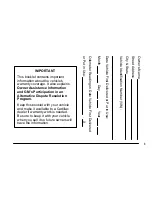
Tires
Inflation
Keeping the tires properly inflated
provides the best combination of
handling, tread life and riding
comfort. Underinflated tires wear
unevenly, adversely affect handling
and fuel economy, and are more
likely to fail from being overheated.
Overinflated tires can make your car
ride more harshly, are more prone to
damage from road hazards, and wear
unevenly.
We recommend that you visually
check your tires every day and use a
gauge to measure the air pressure at
least once a month. If you think a tire
might be low, check it immediately.
Remember to check the spare tire at
the same time you check all the
other tires.
Check the pressure in the tires when
they are cold. This means the car
has been parked for at least three
hours. If you have to drive the car
before checking the tire pressure,
the tires can still be considered
"cold" if you drive less than 1.6 km
(1 mile).
If you check the pressure when the
tires are hot (the car has been driven
several miles), you will see readings
28 to 41 kPa (0.3 to 0.4 kg/cm
2
, 4 to
6 psi) higher than the cold reading.
This is normal. Do not let air out to
match the specified cold pressure.
The tire will be underinflated.
Recommended Tire Pressures for
Normal Driving
The following chart shows the
recommended cold tire pressures for
most normal driving conditions and
speeds. Tire pressures for high
speed driving are shown on page
219
.
(US: DX, LX, Canada: LX)
(US: EX, Canada: EX-R)
The compact spare tire pressure is:
420 kPa (4.2 k g / c m
2
, 60 psi)
The pressures are also given on the
tire information label on the driver's
door jamb.
CONTINUED
Maintenance
Содержание 1994 Accord Coupe
Страница 69: ...Heating and Cooling Comfort and Convenience Features...
Страница 203: ...Fuses INTERIOR FUSE BOX Spare Fuse On Canadian cars CONTINUED Taking Care of the Unexpected...
Страница 204: ...Fuses UNDERHOOD FUSE BOX 1 On Canadian cars 2 US EX Canada EX R ABS FUSE BOX Taking Care of the Unexpected...
















































